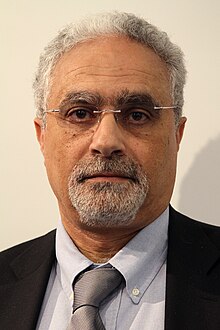Taher A. Elgamal | |
|---|---|
 Taher A. Elgamal (2010) | |
| Born | 18 August 1955 Cairo, Egypt |
| Nationality | American, Egyptian |
| Alma mater | Cairo University (BSc) Stanford University (MS, PhD) |
| Known for | SSL Public-key ElGamal Discrete logarithm cryptography |
| Awards | RSA Conference Lifetime Achievement Award (2009) Marconi Prize (2019) National Academy of Engineering (2022) |
| Scientific career | |
| Fields | Cryptography |
| Institutions | Salesforce.com |
| Doctoral advisor | Martin Hellman |
Taher Elgamal[a] (Arabic: طاهر الجمل) (born 18 August 1955) is an Egyptian cryptographer and entrepreneur. He has served as the Chief Technology Officer (CTO) of Security at Salesforce since 2013.[1] Prior to that, he was the founder and CEO of Securify and the director of engineering at RSA Security. From 1995 to 1998, he was the chief scientist at Netscape Communications. He has been described as the "father of SSL" for the work he did in computer security while working at Netscape, which helped in establishing a private and secure communications on the Internet.[2]
Elgamal's 1985 paper entitled "A Public Key Cryptosystem and A Signature Scheme Based on Discrete Logarithms" proposed the design of the ElGamal discrete log cryptosystem and of the ElGamal signature scheme.[3] The latter scheme became the basis for Digital Signature Algorithm (DSA) adopted by National Institute of Standards and Technology (NIST) as the Digital Signature Standard (DSS).
Cite error: There are <ref group=lower-alpha> tags or {{efn}} templates on this page, but the references will not show without a {{reflist|group=lower-alpha}} template or {{notelist}} template (see the help page).
- ^ "Taher Elgamel LinkedIn".
- ^ Messmer, Ellen (2012-12-04). "Father of SSL, Dr. Taher Elgamal, finds fast-moving IT projects in the Middle East". Network World. Archived from the original on 2020-06-22. Retrieved 2020-06-22.
- ^ Elgamal, Taher (1985). "A Public key Cryptosystem and A Signature Scheme based on discrete Logarithms". IEEE Transactions on Information Theory. 31 (4): 469–472. CiteSeerX 10.1.1.476.4791. doi:10.1109/TIT.1985.1057074. S2CID 2973271.